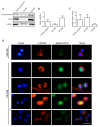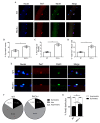Targeting PKCθ Promotes Satellite Cell Self-Renewal
- PMID: 32244482
- PMCID: PMC7177808
- DOI: 10.3390/ijms21072419
Targeting PKCθ Promotes Satellite Cell Self-Renewal
Abstract
Skeletal muscle regeneration following injury depends on the ability of satellite cells (SCs) to proliferate, self-renew, and eventually differentiate. The factors that regulate the process of self-renewal are poorly understood. In this study we examined the role of PKCθ in SC self-renewal and differentiation. We show that PKCθ is expressed in SCs, and its active form is localized to the chromosomes, centrosomes, and midbody during mitosis. Lack of PKCθ promotes SC symmetric self-renewal division by regulating Pard3 polarity protein localization, without affecting the overall proliferation rate. Genetic ablation of PKCθ or its pharmacological inhibition in vivo did not affect SC number in healthy muscle. By contrast, after induction of muscle injury, lack or inhibition of PKCθ resulted in a significant expansion of the quiescent SC pool. Finally, we show that lack of PKCθ does not alter the inflammatory milieu after acute injury in muscle, suggesting that the enhanced self-renewal ability of SCs in PKCθ-/- mice is not due to an alteration in the inflammatory milieu. Together, these results suggest that PKCθ plays an important role in SC self-renewal by stimulating their expansion through symmetric division, and it may represent a promising target to manipulate satellite cell self-renewal in pathological conditions.
Keywords: Protein kinase C θ; muscle regeneration; satellite cells; self-renewal.
Conflict of interest statement
The authors declare no conflict of interest.
Figures







Similar articles
-
Three-dimensional niche stiffness synergizes with Wnt7a to modulate the extent of satellite cell symmetric self-renewal divisions.Mol Biol Cell. 2020 Jul 21;31(16):1703-1713. doi: 10.1091/mbc.E20-01-0078. Epub 2020 Jun 3. Mol Biol Cell. 2020. PMID: 32491970 Free PMC article.
-
Lack of PKCθ Promotes Regenerative Ability of Muscle Stem Cells in Chronic Muscle Injury.Int J Mol Sci. 2020 Jan 31;21(3):932. doi: 10.3390/ijms21030932. Int J Mol Sci. 2020. PMID: 32023816 Free PMC article.
-
Ghrelin knockout mice display defective skeletal muscle regeneration and impaired satellite cell self-renewal.Endocrine. 2018 Oct;62(1):129-135. doi: 10.1007/s12020-018-1606-4. Epub 2018 May 30. Endocrine. 2018. PMID: 29846901
-
Satellite Cell Self-Renewal.Curr Top Dev Biol. 2018;126:177-203. doi: 10.1016/bs.ctdb.2017.08.001. Epub 2017 Oct 23. Curr Top Dev Biol. 2018. PMID: 29304998 Review.
-
Intrinsic and extrinsic mechanisms regulating satellite cell function.Development. 2015 May 1;142(9):1572-81. doi: 10.1242/dev.114223. Development. 2015. PMID: 25922523 Free PMC article. Review.
Cited by
-
Inhibition of PKCθ Improves Dystrophic Heart Phenotype and Function in a Novel Model of DMD Cardiomyopathy.Int J Mol Sci. 2022 Feb 18;23(4):2256. doi: 10.3390/ijms23042256. Int J Mol Sci. 2022. PMID: 35216371 Free PMC article.
-
MuSCs and IPCs: roles in skeletal muscle homeostasis, aging and injury.Cell Mol Life Sci. 2024 Jan 30;81(1):67. doi: 10.1007/s00018-023-05096-w. Cell Mol Life Sci. 2024. PMID: 38289345 Free PMC article. Review.
-
A Simple Method for the Isolation and in vitro Expansion of Highly Pure Mouse and Human Satellite Cells.Bio Protoc. 2021 Dec 5;11(23):e4238. doi: 10.21769/BioProtoc.4238. eCollection 2021 Dec 5. Bio Protoc. 2021. PMID: 35005083 Free PMC article.
-
A novel approach for the isolation and long-term expansion of pure satellite cells based on ice-cold treatment.Skelet Muscle. 2021 Mar 17;11(1):7. doi: 10.1186/s13395-021-00261-w. Skelet Muscle. 2021. PMID: 33731194 Free PMC article.
-
Sex Differences in Inflammation and Muscle Wasting in Aging and Disease.Int J Mol Sci. 2023 Feb 28;24(5):4651. doi: 10.3390/ijms24054651. Int J Mol Sci. 2023. PMID: 36902081 Free PMC article. Review.
References
MeSH terms
Substances
Grants and funding
LinkOut - more resources
Full Text Sources
Molecular Biology Databases

